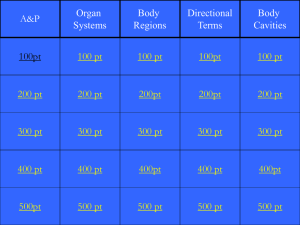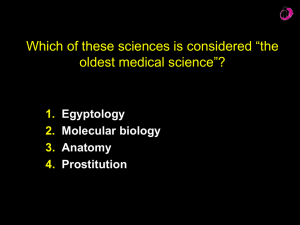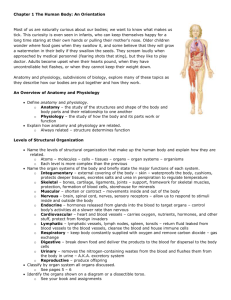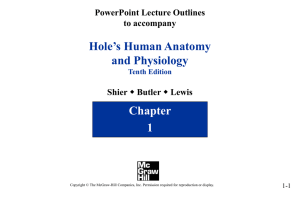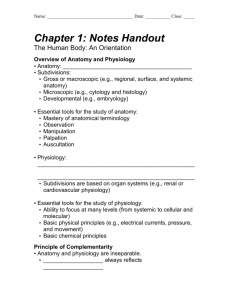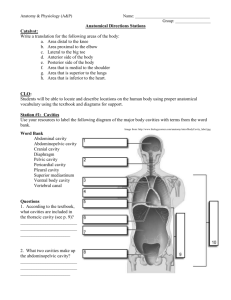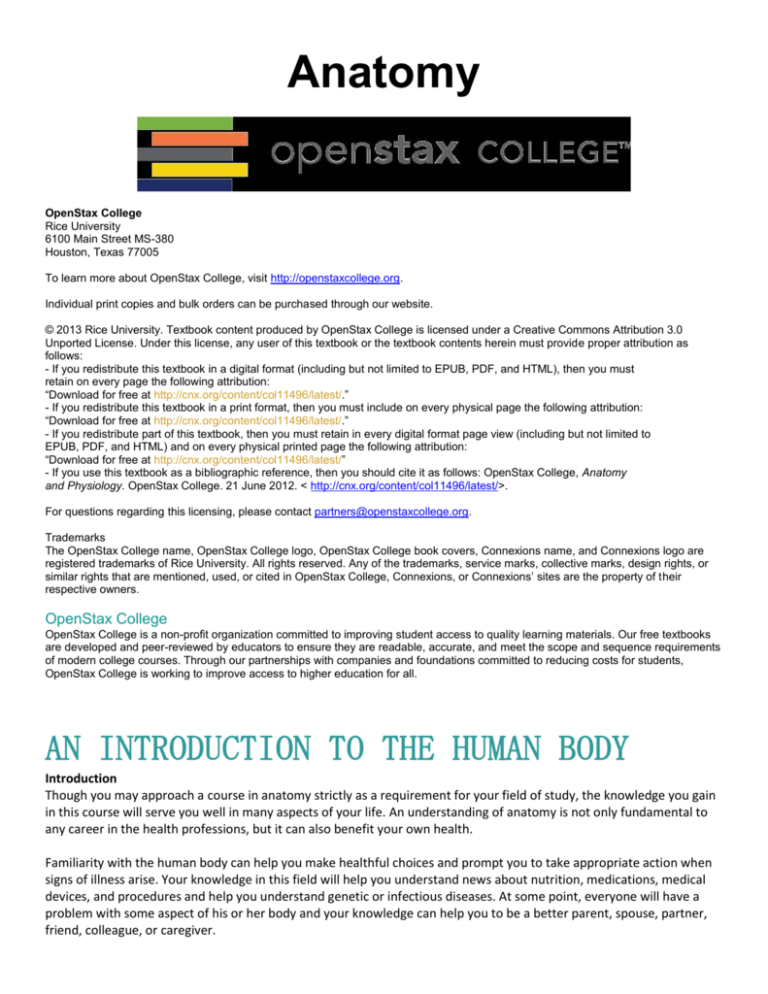
Anatomy
OpenStax College
Rice University
6100 Main Street MS-380
Houston, Texas 77005
To learn more about OpenStax College, visit http://openstaxcollege.org.
Individual print copies and bulk orders can be purchased through our website.
© 2013 Rice University. Textbook content produced by OpenStax College is licensed under a Creative Commons Attribution 3.0
Unported License. Under this license, any user of this textbook or the textbook contents herein must provide proper attribution as
follows:
- If you redistribute this textbook in a digital format (including but not limited to EPUB, PDF, and HTML), then you must
retain on every page the following attribution:
“Download for free at http://cnx.org/content/col11496/latest/.”
- If you redistribute this textbook in a print format, then you must include on every physical page the following attribution:
“Download for free at http://cnx.org/content/col11496/latest/.”
- If you redistribute part of this textbook, then you must retain in every digital format page view (including but not limited to
EPUB, PDF, and HTML) and on every physical printed page the following attribution:
“Download for free at http://cnx.org/content/col11496/latest/”
- If you use this textbook as a bibliographic reference, then you should cite it as follows: OpenStax College, Anatomy
and Physiology. OpenStax College. 21 June 2012. < http://cnx.org/content/col11496/latest/>.
For questions regarding this licensing, please contact partners@openstaxcollege.org.
Trademarks
The OpenStax College name, OpenStax College logo, OpenStax College book covers, Connexions name, and Connexions logo are
registered trademarks of Rice University. All rights reserved. Any of the trademarks, service marks, collective marks, design rights, or
similar rights that are mentioned, used, or cited in OpenStax College, Connexions, or Connexions’ sites are the property of their
respective owners.
OpenStax College
OpenStax College is a non-profit organization committed to improving student access to quality learning materials. Our free textbooks
are developed and peer-reviewed by educators to ensure they are readable, accurate, and meet the scope and sequence requirements
of modern college courses. Through our partnerships with companies and foundations committed to reducing costs for students,
OpenStax College is working to improve access to higher education for all.
AN INTRODUCTION TO THE HUMAN BODY
Introduction
Though you may approach a course in anatomy strictly as a requirement for your field of study, the knowledge you gain
in this course will serve you well in many aspects of your life. An understanding of anatomy is not only fundamental to
any career in the health professions, but it can also benefit your own health.
Familiarity with the human body can help you make healthful choices and prompt you to take appropriate action when
signs of illness arise. Your knowledge in this field will help you understand news about nutrition, medications, medical
devices, and procedures and help you understand genetic or infectious diseases. At some point, everyone will have a
problem with some aspect of his or her body and your knowledge can help you to be a better parent, spouse, partner,
friend, colleague, or caregiver.
This chapter begins with an overview of anatomy and a preview of the body regions and functions. It then covers the
characteristics of life and how the body works to maintain stable conditions. It introduces a set of standard terms for
body structures and for planes and positions in the body that will serve as a foundation for more comprehensive
information covered later in the text. It ends with examples of medical imaging used to see inside the living body.
Human anatomy is the scientific study of the body’s structures. Some of these structures are very small and can only be
observed and analyzed with the assistance of a microscope. Other larger structures can readily be seen, manipulated,
measured, and weighed. The word “anatomy” comes from a Greek root that means “to cut apart.” Human
anatomy was first studied by observing the exterior of the body and observing the wounds of soldiers and other injuries.
Later, physicians were allowed to dissect bodies of the dead to augment their knowledge. When a body is dissected, its
structures are cut apart in order to observe their physical attributes and their relationships to one another. Dissection is
still used in medical schools, anatomy courses, and in pathology labs. In order to observe structures in living people,
however, a number of imaging techniques have been developed. These techniques allow clinicians to visualize
structures inside the living body such as a cancerous tumor or a fractured bone.
Like most scientific disciplines, anatomy has areas of specialization. Gross anatomy is the study of the larger structures
of the body, those visible without the aid of magnification (Figure 1.2a). Macro- means “large,” thus, gross anatomy is
also referred to as macroscopic anatomy. In contrast, micro- means “small,” and microscopic anatomy is the study of
structures that can be observed only with the use of a microscope or other magnification devices (Figure 1.2b).
Microscopic anatomy includes cytology, the study of cells and histology, the study of tissues. As the technology of
microscopes has advanced, anatomists have been able to observe smaller and smaller structures of the body, from slices
of large structures like the heart, to the three-dimensional structures of large molecules in the body.
Figure 1.2 Gross and Microscopic Anatomy (a) Gross anatomy considers large structures such as the brain.
(b) Microscopic anatomy can deal with the same structures, though at a different scale.
This is a micrograph of nerve cells from the brain. LM × 1600
Anatomists take two general approaches to the study of the body’s structures: regional and systemic. Regional anatomy
is the study of the interrelationships of all of the structures in a specific body region, such as the abdomen. Studying
regional anatomy helps us appreciate the interrelationships of body structures, such as how muscles, nerves, blood
vessels, and other structures work together to serve a particular body region.
In contrast, systemic anatomy is the study of the structures that make up a discrete body system—that is, a group of
structures that work together to perform a unique body function. For example, a systemic anatomical study of the
muscular system would consider all of the skeletal muscles of the body. Whereas anatomy is about structure, physiology
is about function. Human physiology is the scientific study of the chemistry and physics of the structures of the body
and the ways in which they work together to support the functions of life.
Structural Organization of the Human Body
Before you begin to study the different structures and functions of the human body, it is helpful to consider its basic
architecture; that is, how its smallest parts are assembled into larger structures. It is convenient to consider the
structures of the body in terms of six fundamental levels of organization that increase in complexity: chemical, cellular,
tissue, organ, organ system, organism (Figure 1.3).
Figure 1.3 Levels of Structural Organization of the Human Body The organization of the body often is
discussed in terms of six distinct levels of increasing complexity,
from the smallest chemical building blocks to a unique human organism.
The Six Levels of Organization
To study the chemical level of organization, scientists consider the simplest building blocks of matter: atoms and
molecules. All matter in the universe is composed of one or more unique pure substances called elements, familiar
examples of which are hydrogen, oxygen, carbon, nitrogen, calcium, and iron. The smallest unit of any of these pure
substances (elements) is an atom. Two or more atoms combine to form a molecule, such as the water molecules,
proteins, and sugars found in living things. Molecules are the chemical building blocks of all body structures.
A cell is the smallest independently functioning unit of a living organism. Even bacteria, which are extremely small,
independently-living organisms, have a cellular structure. Each bacterium is a single cell. All living structures of human
anatomy contain cells, and almost all functions of human physiology are performed in cells or are initiated by cells. A
human cell typically consists of flexible membranes that enclose cytoplasm, a water-based cellular fluid together with a
variety of tiny functioning units called organelles. In humans, as in all organisms, cells perform all functions of life.
A tissue is a group of many similar cells (though sometimes composed of a few related types) that work together to
perform a specific function. An organ is an anatomically distinct structure of the body composed of two or more tissue
types. Each organ performs one or more specific physiological functions. An organ system is a group of organs that work
together to perform major functions or meet physiological needs of the body.
This book covers eleven distinct organ systems in the human body (Figure 1.4 and Figure 1.5). Assigning organs to organ
systems can be imprecise since organs that “belong” to one system can also have functions integral to another
system. In fact, most organs contribute to more than one system.
The organism level is the highest level of organization. An organism is a living being that has a cellular structure and that
can independently perform all physiologic functions necessary for life. In multicellular organisms, including humans, all
cells, tissues, organs, and organ systems of the body work together to maintain the life and health of the organism.
The different organ systems each have different functions and therefore unique roles to perform in physiology. These
many functions can be summarized in terms of a few that we might consider definitive of human life: organization,
metabolism, responsiveness, movement, development, and reproduction.
Organization
A human body consists of trillions of cells organized in a way that maintains distinct internal compartments. These
compartments keep body cells separated from external environmental threats and keep the cells moist and nourished.
They also separate internal body fluids from the countless microorganisms that grow on body surfaces, including the
lining of certain tracts, or passageways. The intestinal tract, for example, is home to even more bacteria cells than the
total of all human cells in the body, yet these bacteria are outside the body and cannot be allowed to circulate freely
inside the body.
Cells, for example, have a cell membrane (also referred to as the plasma membrane) that keeps the intracellular
environment—the fluids and organelles—separate from the extracellular environment. Blood vessels keep blood inside a
closed circulatory system, and nerves and muscles are wrapped in connective tissue sheaths that separate them from
surrounding structures. In the chest and abdomen, a variety of internal membranes keep major organs such as the lungs,
heart, and kidneys separate from others.
The body’s largest organ system is the integumentary system, which includes the skin and its associated structures, such
as hair and nails. The surface tissue of skin is a barrier that protects internal structures and fluids from potentially
harmful microorganisms and other toxins.
Figure 1.4 Organ Systems of the Human Body Organs that work together are grouped into organ systems.
Figure 1.5 Organ Systems of the Human Body (continued)
Organs that work together are grouped into organ systems.
Development
Development is all of the changes the body goes through in life. Development includes the processes of differentiation,
growth, and renewal.
Differentiation is the process whereby unspecialized cells become specialized in both structure and function. After
conception, when a female’s egg cell is fertilized by a male’s sperm cell, the fertilized egg begins to multiply, initially into
a cluster of identical unspecialized cells. As cell division continues, however, the cells begin to undergo differentiation
into distinct tissue layers, and eventually into all of the specialized cells, tissues, and organs of the fetus. The progression
from the undifferentiated cells to certain types of differentiated cells goes on throughout life, even in the bodies of
adults.
Growth is the increase in body size. Humans, like all multicellular organisms, grow by increasing the number of existing
cells, increasing the amount of non-cellular material around cells (such as mineral deposits in bone), and, within very
narrow limits, increasing the size of existing cells. Migration of cells to their final locations in the body is also an
important area of study in human growth.
Renewal is the formation of new cells for growth, repair, or replacement. In some organ systems, such as the digestive
system, worn-out cells are constantly replaced throughout life. Some other specialized cells, however, have only a
limited capacity for renewal. This is true, for example, of nerve cells of the nervous system. When death of such cells is
extensive (as can occur in a stroke, which causes cell death in the brain), the system can fail. Because the body is an
integrated whole, failure of a body system can ultimately lead to the death of the organism.
Reproduction is the formation of a new organism from parent organisms. In humans, reproduction is carried out by the
male and female reproductive systems. Because death will come to all complex organisms, without reproduction, the
line of organisms would end.
Anatomical Terminology
Anatomists and health care providers use terminology that can be bewildering to the uninitiated. However, the purpose
of this language is not to confuse, but rather to increase precision and reduce medical errors. For example, is a scar
“above the wrist” located on the forearm two or three inches away from the hand? Or is it at the base of the hand? Is
it on the palmside or back-side? By using precise anatomical terminology, we eliminate ambiguity. Anatomical terms
derive from ancient Greek and Latin words. Because these languages are no longer used in everyday conversation, the
meaning of their words does not change.
Anatomical terms are made up of roots, prefixes, and suffixes. The root of a term often refers to an organ, tissue, or
condition, whereas the prefix or suffix often describes the root. For example, in the disorder hypertension, the prefix
“hyper-” means “high” or “over,” and the root word “tension” refers to pressure, so the word
“hypertension” refers to abnormally high blood pressure.
Anatomical Position
To further increase precision, anatomists standardize the way in which they view the body. Just as maps are normally
oriented with north at the top, the standard body “map,” or anatomical position, is that of the body standing upright,
with the feet at shoulder width and parallel, toes forward. The upper limbs are held out to each side, and the palms of
the hands face forward as illustrated in Figure 1.12. Using this standard position reduces confusion. It does not matter
how the body being described is oriented, the terms are used as if it is in anatomical position. For example, a scar in the
“anterior (front) carpal (wrist) region” would be present on the palm side of the wrist. The term “anterior” would
be used even if the hand were palm down on a table.
A body that is lying down is described as either prone or supine. Prone describes a face-down orientation, and supine
describes a face up orientation. These terms are sometimes used in describing the position of the body during specific
physical examinations or surgical procedures.
Regional Terms
The human body’s numerous regions have specific terms to help increase precision (see Figure 1.12). Notice that the
term “brachium” or “arm” is reserved for the “upper arm” and “antebrachium” or “forearm” is used
rather than “lower arm.”Similarly, “femur” or “thigh” is correct, and “leg” or “crus” is reserved for the
portion of the lower limb between the knee and the ankle. You will be able to describe the body’s regions using the
terms from the figure.
Directional Terms
Certain directional anatomical terms appear throughout this and any other anatomy textbook (Figure 1.13). These terms
are essential for describing the relative locations of different body structures. For instance, an anatomist might describe
one band of tissue as “inferior to” another or a physician might describe a tumor as “superficial to” a deeper body
structure. Commit these terms to memory to avoid confusion when you are studying or describing the locations of
particular body parts.
• Anterior (or ventral) Describes the front or direction toward the front of the body. The toes are anterior to the foot.
• Posterior (or dorsal) Describes the back or direction toward the back of the body. The popliteus is posterior to the
patella.
Figure 1.12 Regions of the Human Body The human body is shown in anatomical position in an
(a) anterior view and a (b) posterior view. The regions of the body are labeled in boldface.
• Superior (or cranial) describes a position above or higher than another part of the body proper. The orbits are superior
to the oris.
• Inferior (or caudal) describes a position below or lower than another part of the body proper; near or toward the tail
(in humans, the coccyx, or lowest part of the spinal column). The pelvis is inferior to the abdomen.
• Lateral describes the side or direction toward the side of the body. The thumb (pollex) is lateral to the digits.
• Medial describes the middle or direction toward the middle of the body. The hallux is the medial toe.
• Proximal describes a position in a limb that is nearer to the point of attachment or the trunk of the body. The
brachium is proximal to the antebrachium.
• Distal describes a position in a limb that is farther from the point of attachment or the trunk of the body. The crus is
distal to the femur.
• Superficial describes a position closer to the surface of the body. The skin is superficial to the bones.
• Deep describes a position farther from the surface of the body. The brain is deep to the skull.
Figure 1.13 Directional Terms Applied to the Human Body Paired directional terms are shown as applied to the
human body.
Body Planes
A section is a two-dimensional surface of a three-dimensional structure that has been cut. Modern medical imaging
devices enable clinicians to obtain “virtual sections” of living bodies. We call these scans. Body sections and scans can
be correctly interpreted, however, only if the viewer understands the plane along which the section was made. A plane
is an imaginary two-dimensional surface that passes through the body. There are three planes commonly referred to in
anatomy and medicine, as illustrated in Figure 1.14.
• The sagittal plane is the plane that divides the body or an organ vertically into right and left sides. If this vertical plane
runs directly down the middle of the body, it is called the midsagittal or median plane. If it divides the body into unequal
right and left sides, it is called a parasagittal plane or less commonly a longitudinal section.
• The frontal plane is the plane that divides the body or an organ into an anterior (front) portion and a posterior (rear)
portion. The frontal plane is often referred to as a coronal plane. (“Corona” is Latin for “crown.”)
• The transverse plane is the plane that divides the body or organ horizontally into upper and lower portions.
Transverse planes produce images referred to as cross sections.
Figure 1.14 Planes of the Body The three planes most commonly used in anatomical and
medical imaging are the sagittal, frontal (or coronal), and transverse plane.
Body Cavities and Serous Membranes
The body maintains its internal organization by means of membranes, sheaths, and other structures that separate
compartments. The dorsal (posterior) cavity and the ventral (anterior) cavity are the largest body compartments
(Figure 1.15). These cavities contain and protect delicate internal organs, and the ventral cavity allows for significant
changes in the size and shape of the organs as they perform their functions. The lungs, heart, stomach, and intestines,
for example, can expand and contract without distorting other tissues or disrupting the activity of nearby organs.
Figure 1.15 Dorsal and Ventral Body Cavities The ventral cavity includes the thoracic and
abdominopelvic cavities and their subdivisions. The dorsal cavity includes the cranial and spinal cavities.
Subdivisions of the Posterior (Dorsal) and Anterior (Ventral) Cavities
The posterior (dorsal) and anterior (ventral) cavities are each subdivided into smaller cavities. In the posterior (dorsal)
cavity, the cranial cavity houses the brain, and the spinal cavity (or vertebral cavity) encloses the spinal cord. Just as the
brain and spinal cord make up a continuous, uninterrupted structure, the cranial and spinal cavities that house them are
also continuous. The brain and spinal cord are protected by the bones of the skull and vertebral column and by
cerebrospinal fluid, a colorless fluid produced by the brain, which cushions the brain and spinal cord within the posterior
(dorsal) cavity.
The anterior (ventral) cavity has two main subdivisions: the thoracic cavity and the abdominopelvic cavity (see Figure
1.15). The thoracic cavity is the more superior subdivision of the anterior cavity, and it is enclosed by the rib cage. The
thoracic cavity contains the lungs and the heart, which is located in the mediastinum. The diaphragm forms the floor of
the thoracic cavity and separates it from the more inferior abdominopelvic cavity. The abdominopelvic cavity is the
largest cavity in the body. Although no membrane physically divides the abdominopelvic cavity, it can be useful to
distinguish between the abdominal cavity, the division that houses the digestive organs, and the pelvic cavity, the
division that houses the organs of reproduction.
Abdominal Regions and Quadrants
To promote clear communication, for instance about the location of a patient’s abdominal pain or a suspicious mass,
health care providers typically divide up the cavity into either nine regions or four quadrants (Figure 1.16).
The more detailed regional approach subdivides the cavity with one horizontal line immediately inferior to the ribs and
one immediately superior to the pelvis, and two vertical lines drawn as if dropped from the midpoint of each clavicle
(collarbone). There are nine resulting regions. The simpler quadrants approach, which is more commonly used in
medicine, subdivides the cavity with one horizontal and one vertical line that intersect at the patient’s umbilicus (navel).
Figure 1.16 Regions and Quadrants of the Peritoneal Cavity There are (a) nine abdominal regions and
(b) four abdominal quadrants in the peritoneal cavity.
Membranes of the Anterior (Ventral) Body Cavity
A serous membrane (also referred to a serosa) is one of the thin membranes that cover the walls and organs in the
thoracic and abdominopelvic cavities. The parietal layers of the membranes line the walls of the body cavity (parietrefers to a cavity wall). The visceral layer of the membrane covers the organs (the viscera). Between the parietal and
visceral layers is a very thin, fluid-filled serous space, or cavity (Figure 1.17).
Figure 1.17 Serous Membrane Serous membrane lines the pericardial cavity and reflects back to cover the
heart—much the same way that an underinflated balloon would form two layers surrounding a fist.
Medical Imaging
For thousands of years, fear of the dead and legal sanctions limited the ability of anatomists and physicians to study the
internal structures of the human body. An inability to control bleeding, infection, and pain made surgeries infrequent,
and those that were performed—such as wound suturing, amputations, tooth and tumor removals, skull drilling, and
cesarean births—did not greatly advance knowledge about internal anatomy. Theories about the function of the body
and about disease were therefore largely based on external observations and imagination. During the fourteenth and
fifteenth centuries, however, the detailed anatomical drawings of Italian artist and anatomist Leonardo da Vinci and
Flemish anatomist Andreas Vesalius were published, and interest in human anatomy began to increase. Medical schools
began to teach anatomy using human dissection; although some resorted to grave robbing to obtain corpses. Laws were
eventually passed that enabled students to dissect the corpses of criminals and those who donated their bodies for
research. Still, it was not until the late nineteenth century that medical researchers discovered non-surgical methods to
look inside the living body.
X-Rays
German physicist Wilhelm Rontgen (1845–1923) was experimenting with electrical current when he discovered that a
mysterious and invisible “ray” would pass through his flesh but leave an outline of his bones on a screen coated with
a metal compound. In 1895, Rontgen made the first durable record of the internal parts of a living human: an “X-ray”
image (as it came to be called) of his wife’s hand. Scientists around the world quickly began their own experiments with
X-rays, and by 1900, X-rays were widely used to detect a variety of injuries and diseases. In 1901, Rontgen was awarded
the first Nobel Prize for physics for his work in this field.
The X-ray is a form of high energy electromagnetic radiation with a short wavelength capable of penetrating solids and
ionizing gases. As they are used in medicine, X-rays are emitted from an X-ray machine and directed toward a specially
treated metallic plate placed behind the patient’s body. The beam of radiation results in darkening of the X-ray plate.
X-rays are slightly impeded by soft tissues, which show up as gray on the X-ray plate, whereas hard tissues, such as bone,
largely block the rays, producing a light-toned “shadow.” Thus, X-rays are best used to visualize hard body structures
such as teeth and bones (Figure 1.18). Like many forms of high energy radiation, however, X-rays are capable of
damaging cells and initiating changes that can lead to cancer. This danger of excessive exposure to X-rays was not fully
appreciated for many years after their widespread use.
Figure 1.18 X-Ray of a Hand High energy electromagnetic radiation allows the internal structures of the body, such
as bones, to be seen in X-rays like these. (credit: Trace Meek/flickr)
Refinements and enhancements of X-ray techniques have continued throughout the twentieth and twenty-first
centuries. Although often supplanted by more sophisticated imaging techniques, the X-ray remains a “workhorse” in
medical imaging, especially for viewing fractures and for dentistry. The disadvantage of irradiation to the patient and the
operator is now attenuated by proper shielding and by limiting exposure.
Modern Medical Imaging
X-rays can depict a two-dimensional image of a body region, and only from a single angle. In contrast, more recent
medical imaging technologies produce data that is integrated and analyzed by computers to produce three-dimensional
images or images that reveal aspects of body functioning.
Computed Tomography
Tomography refers to imaging by sections. Computed tomography (CT) is a noninvasive imaging technique that uses
computers to analyze several cross-sectional X-rays in order to reveal minute details about structures in the body (Figure
1.19a). The technique was invented in the 1970s and is based on the principle that, as X-rays pass through the body,
they are absorbed or reflected at different levels. In the technique, a patient lies on a motorized platform while a
computerized axial tomography (CAT) scanner rotates 360 degrees around the patient, taking X-ray images. A computer
combines these images into a two-dimensional view of the scanned area, or “slice.”
Figure 1.19 Medical Imaging Techniques (a) The results of a CT scan of the head are shown as
successive transverse sections. (b) An MRI machine generates a magnetic field around a patient.
(c) PET scans use radiopharmaceuticals to create images of active blood flow and physiologic
activity of the organ or organs being targeted. (d) Ultrasound technology is used to monitor pregnancies
because it is the least invasive of imaging techniques and uses no electromagnetic radiation.
Since 1970, the development of more powerful computers and more sophisticated software has made CT scanning
routine for many types of diagnostic evaluations. It is especially useful for soft tissue scanning, such as of the brain and
the thoracic and abdominal viscera. Its level of detail is so precise that it can allow physicians to measure the size of a
mass down to a millimeter. The main disadvantage of CT scanning is that it exposes patients to a dose of radiation many
times higher than that of X-rays. In fact, children who undergo CT scans are at increased risk of developing cancer, as are
adults who have multiple CT scans.
Magnetic Resonance Imaging
Magnetic resonance imaging (MRI) is a noninvasive medical imaging technique based on a phenomenon of nuclear
physics discovered in the 1930s, in which matter exposed to magnetic fields and radio waves was found to emit radio
signals. In 1970, a physician and researcher named Raymond Damadian noticed that malignant (cancerous) tissue gave
off different signals than normal body tissue. He applied for a patent for the first MRI scanning device, which was in use
clinically by the early 1980s. The early MRI scanners were crude, but advances in digital computing and electronics led to
their advancement over any other technique for precise imaging, especially to discover tumors. MRI also has the major
advantage of not exposing patients to radiation.
Drawbacks of MRI scans include their much higher cost, and patient discomfort with the procedure. The MRI scanner
subjects the patient to such powerful electromagnets that the scan room must be shielded. The patient must be nclosed
in a metal tube-like device for the duration of the scan (see Figure 1.19b), sometimes as long as thirty minutes, which
can be uncomfortable and impractical for ill patients. The device is also so noisy that, even with earplugs, patients can
become anxious or even fearful. These problems have been overcome somewhat with the development of “open”
MRI scanning, which does not require the patient to be entirely enclosed in the metal tube. Patients with iron-containing
metallic implants (internal sutures, some prosthetic devices, and so on) cannot undergo MRI scanning because it can
dislodge these implants.
Functional MRIs (fMRIs), which detect the concentration of blood flow in certain parts of the body, are increasingly
being used to study the activity in parts of the brain during various body activities. This has helped scientists learn more
about the locations of different brain functions and more about brain abnormalities and diseases.
Positron Emission Tomography
Positron emission tomography (PET) is a medical imaging technique involving the use of so-called radiopharmaceuticals,
substances that emit radiation that is short-lived and therefore relatively safe to administer to the body. Although the
first PET scanner was introduced in 1961, it took 15 more years before radiopharmaceuticals were combined with the
technique and revolutionized its potential. The main advantage is that PET (see Figure 1.19c) can illustrate physiologic
activity—including nutrient metabolism and blood flow—of the organ or organs being targeted, whereas CT and MRI scans
can only show static images. PET is widely used to diagnose a multitude of conditions, such as heart disease, the spread
of cancer, certain forms of infection, brain abnormalities, bone disease, and thyroid disease.
Ultrasonography
Ultrasonography is an imaging technique that uses the transmission of high-frequency sound waves into the body to
generate an echo signal that is converted by a computer into a real-time image of anatomy and physiology (see Figure
1.19d). Ultrasonography is the least invasive of all imaging techniques, and it is therefore used more freely in sensitive
situations such as pregnancy. The technology was first developed in the 1940s and 1950s. Ultrasonography is used to
study heart function, blood flow in the neck or extremities, certain conditions such as gallbladder disease, and fetal
growth and development. The main disadvantages of ultrasonography are that the image quality is heavily operatordependent and that it is unable to penetrate bone and gas.
Embryology
Where we came from: Embryology: Day 1 Lecture
The following diagrams on embryonic development supplement the brief lecture material on development. You do not
need to memorize everything in these diagrams. You are only responsible for whatever is discussed in class and so only
need to know the terms appearing in these diagrams that you have in your class notes from lecture.
The blastocyst contains three primary components: the inner cell mass, which can become the adult organism, the
trophoblast, which becomes the placenta, and the blastocoele, which is a fluid-filled space. The blastocyst develops into
the gastrula, a later stage embryo.
The Cell:
Phospholipid bilayer:
The term permeable means that a structure, such as a membrane, permits the passage of substances through it,
while impermeable means that a structure does not permit the passage of substances through it. Selective
permeability means a membrane permit some, but not all, substances across it.
The lipid bilayer portion of a phospholipid bilayer is permeable to some molecules such as oxygen, carbon
dioxide, and steroid hormones but is impermeable to ions and molecules such as glucose. It is also permeable to
water.
Transmembrane proteins that act as tunnels or channels or transporters allow for the passage of small and
medium sized charged substances (including ions) that cannot cross the lipid bilayer without help. You can see
from the diagram below that proteins with small sugar groups attached are called ‘glycoproteins’. Whereas
triglycerides (fats) with small sugars attached to them are called glycolipids. Macromolecules, such as proteins,
cannot pass through the plasma membrane except by endocytosis and exocytosis.
Intracellular fluid = fluid within cells; or another more common term for this fluid is the cytosol.
Extracellular fluid = fluid outside cells.
-Interstitial fluid: the extracellular fluid in between cells
-Plasma: the extracellular fluid found in the blood vessels
Passive movement across a plasma membrane (a phospholipid bilayer) required no ATP and involves diffusion,
the movement of molecules from areas of high concentration to areas of low concentration. The three types of
passive movement were discussed in class. They were Simple Diffusion; Facilitated Diffusion; and Osmosis.
Active transport mechanisms require ATP energy, generally to move molecules against their concentration
gradient (to move molecules from areas of low concentration to areas of high concentration).
Endocytosis is the uptake by a cell of material from the environment by invagination of its plasma membrane; it
includes both phagocytosis and pinocytosis. It is a process by which substances are taken into the cell. When the
cell membrane comes into contact with a suitable food, a portion of the cell cytoplasm surges forward to meet
and surround the material and a depression forms within the cell wall. The depression deepens and the
movement of the cytoplasm continues until the food is completely engulfed in a pocket called a vesicle. The
vesicle then drifts further into the body of the cell where it meets and fuses with a lysosome, a vesicle normally
found in the cell that contains digestive enzymes. The food is then broken down into molecules and ions that are
suitable for the cell's use. There are two types of endocytosis: pinocytosis, the engulfing and digestion of
dissolved substances, and phagocytosis, the engulfing and digestion of microscopically visible particles.
Exocytosis is a process in which an intracellular vesicle (membrane bounded sphere) moves to the plasma
membrane and subsequent fusion of the vesicular membrane and plasma membrane ensues.



